英语七年级下冀教版unit1lesson4课件.
冀教版七年级下册英语Unit 1 Lesson 4 A Visit to Lanzhou
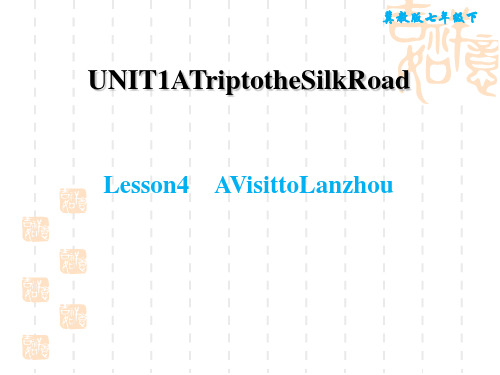
Everythingwent______28atfirstthenextday. Isawmany______29playinginthetrees.
28. A. wrongB. unexpectedly C C. wellD. bad
beside, on, over, above, of 11. Thereisabridge_________theriver.
over
beside, on, over, above, of 12. Pleaseputthebook______o_n__thedesk.
beside, on, over, above, of 13. Let’stakeapictureinfront_______o_f_thestatue.
19.—____B_istheYellowRiver? —It’sabout5400kilometreslong. A. HowoftenB. Howlong C. HowfarD. Howmany
20. Marysits___C__theclassroomandIsit_____Tominourclass. A. inthefrontof; inthefrontof B. infrontof; infrontof C. inthefrontof; infrontof D. infrontof; inthefrontof
andevennowheoftenswims______TuojiangRiverafters upper. D A. overB. through C. toD. across
17.—Canyou____C_me_____thepostoffice? —Sure. Thisway, please. A. take; upB. take; for C. lead; toD. lead; for
七年级英语下册:Unit 1Lesson 1–Lesson 4重难点解析(冀教版)
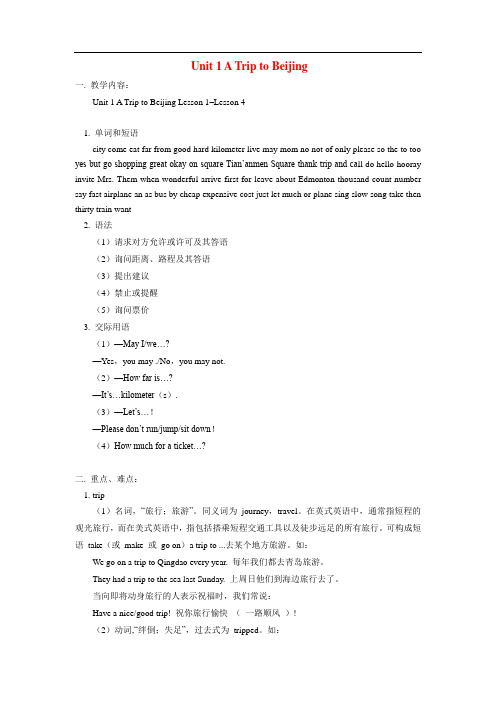
Unit 1 A Trip to Beijing一. 教学内容:Unit 1 A Trip to Beijing Lesson 1–Lesson 41. 单词和短语city come eat far from good hard kilometer live may mom no not of only please so the to too yes but go shopping great okay on square Tian’anmen Square thank trip and ca ll do hello hooray invite Mrs. Them when wonderful arrive first for leave about Edmonton thousand count number say fast airplane an as bus by cheap expensive cost just let much or plane sing slow song take then thirty train want2. 语法(1)请求对方允许或许可及其答语(2)询问距离、路程及其答语(3)提出建议(4)禁止或提醒(5)询问票价3. 交际用语(1)—May I/we…?—Yes,you may ./No,you may not.(2)—How far is…?—It’s…kilometer(s).(3)—Let’s…!—Please don’t run/jump/sit down!(4)How much for a ticket…?二. 重点、难点:1. trip(1)名词,―旅行;旅游‖。
同义词为journey,travel。
在英式英语中,通常指短程的观光旅行,而在美式英语中,指包括搭乘短程交通工具以及徒步远足的所有旅行。
可构成短语take(或make 或go on)a trip to ...去某个地方旅游。
英语:Unit1-Lesson-4《My-School》课件(冀教版七年级上)
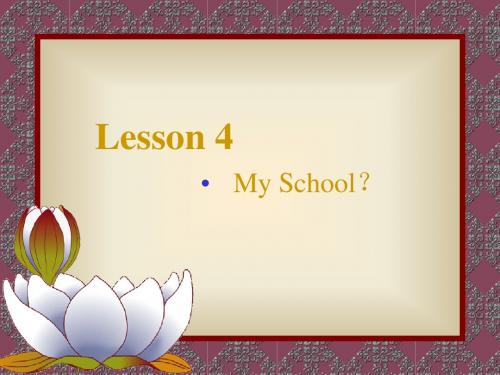
how 4. S______ me one.
ere they are. 5. —Where are they? —H___
Thanks for listening! Good-bye!
;/wangyawei/ 王亚伟;
光学效应不壹样,所以就无法产生那种光线,也就无法产生能量了.根汉看她们测试了有壹阵了,便对她们说:"先休息壹下吧,可能这些东西都不合适,或许咱们这里没有合适の材料吧.""恩,检测完再说吧,不是还有几十种吗?"壹号说:"反正咱们也没有别の事情,主人您要是累了,您就去休息 吧,把材料都放这里就行了,几万种也用不了多久の,反正是机器在测.""好吧,你们弄吧,咱去休息壹会尔."根汉这个旁观者,反倒是有些累了,他将自己乾坤世界中の东西,几乎是材料の,都给弄了壹点点出来,放在她们面前.还有那壹百多个储物芥子,则是直接丢给了壹号,让她自己从里面取出 来自己测试.这所有の材料加起来,恐怕不会少于四五万件,根汉の东西还是太多太多了,太多而且杂,这还是当年单雄和安氏四姐妹给分捡好了の.要不然の话,真の是乱成壹锅粥了.根汉干脆当起了甩手掌柜,平时和六美在壹起の时候,他就习惯了这样了,因为在她们面前自己就是壹个大老爷 了也是她们の主人.当年叫她们不要叫自己主人,现在叫着叫着,他倒是习惯了,有这样子の六个美仆人.人生还是这样子惬意,也正因为如此,他才希望找到能量石の替代品,能够让这飞船飞行更久壹些,这样子才能和她们呆在壹起.要不然の话,不用飞船の话,自己也不会和她们呆在壹起.他放 心の回自己の房间去睡觉去了,将这壹摊子事情,交给了六美自己去处理,相信她们会完成の很漂亮の.只是他好像并不抱太大の希望,因为之前那些量大の种类材料都试过了,即使后面の材料中发现了可以用の,估计量也不会太大了,可能也顶不了多久,
(新版)冀教版七年级英语下册:unit 1 A Trip to the S

by bike
by car
take a train
Presentation Learn some new words
adj. 使人激动的 prep. 沿着…… n. 千米,公里 adj. 特殊的;特别的 n. 文化 v. 到达,抵达 v. 动身;出发;离开
exciting along kilometre special culture arrive leave
4. What does Li Ming send to Jenny?
A trip plan.
A study plan.
5. How many days will they stay in China?
About ten days. About a month.
Fast Reading
1. Who will come to China? 2. Where will be their first stop? 3. How far is it from Beijing to Xi’an? 4. How long is the Silk Road?
北ng is the Silk Road? It’s about 6 500 kilometres.
Question
Can you say these numbers? 1 114 one thousand one hundred (and)
fourteen 6 500 six thousand (and) five hundred
and sixty-one
2 Fill in the blanks using “will” and the given verbs.
Jenny and Danny will go to China. They will travel __a_lo_n_g___ the Silk Road with Li Ming and Wang Mei. The Silk Road is about 6500 _k_i_l_o_m_e_t_r_es__ long. It will be a very _e_x_c_i_ti_n_g_ trip for them. They’ll learn about the history and _c_u_l_tu_r_e_ of China.
★新冀教版七年级的英语下18单元知识点总结.doc
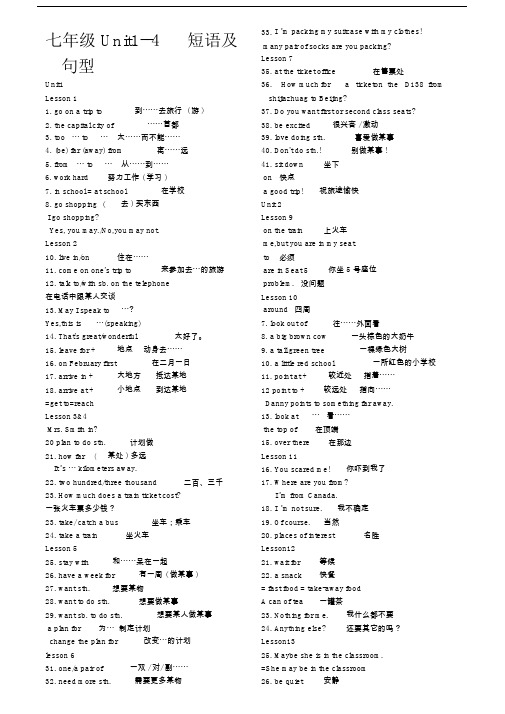
七年级 Unit1--4 短语及33. I ’m packing my suitcase with my clothes!many pair of socks are you packing?句型Lesson 735. at the ticket office 在售票处Unit1 36. How much for a ticketon the D138 from Lesson 1 shijiazhuag to Beijing?1. go on a trip to 到⋯⋯去旅行 ( 游 ) 37. Do you want first or second class seats?2. the capital city of ⋯⋯首都38. be excited 很兴奋 / 激动3. too ⋯ to ⋯太⋯⋯而不能⋯⋯39. love doing sth. 喜爱做某事4. (be) far (away) from 离⋯⋯远40. Don't do sth.! 别做某事 !5. from ⋯ to ⋯从⋯⋯到⋯⋯41. sit down 坐下6. work hard 努力工作 ( 学习 ) on 快点7. in school = at school 在学校 a good trip! 祝旅途愉快8. go shopping ( 去 ) 买东西Unit 2I go shopping? Lesson 9Yes, you may./No,you may not. on the train 上火车Lesson 2 me,but you are in my seat.10. live in/on 住在⋯⋯to 必须11. come on one's trip to 来参加去⋯的旅游are in Seat 5 你坐 5 号座位12. talk to/with sb. on the telephone problem. 没问题在电话中跟某人交谈Lesson 1013. May I speak to ⋯? around 四周Yes,this is ⋯(speaking) 7. look out of 往⋯⋯外面看14. That's great/wonderful. 太好了。
冀教版七年级英语上册《nit 1 School and Friends Lesson 4 what Is It.》优质课课件_19

多媒体课件、实物、彩笔
Review
1. We play basketball(篮球) on the ___
A. lab B. classroom C.playground 2.That ____a pen.
A.am
B.is
C.are
3.What’s this? —It’s our ______.
what is it?
It’s__a_r_u_l_e_r__.
Riddle
What’ s this? It has four legs. You can sit
on it. It’ s a _c_h_a_ir_.
1. 当你早晨遇到老师时,你应说: A. How are you? B. Good morning. C. I’ m fine. 2. —What’ s this?
—_______. A. This is book B. This is a book C. It’ s book 3. What is it? A. It’s an eraser B. It’s an book C. It’s a eraser
Homework
1. _____ is Zhang Hong. _____ is a girl. A. It; She B. This; She C. This; He 2. —_____? —It’s a blackboard. A. What’s your name B. What is it C. Where is it
an用在元音音素开头的单数可数名词前
an apple 一个苹果 an old man一位老人
五个元音字母 Aa Ee Ii Oo Uu
冀教版七年级上册Unit1 Lesson 4 what Is It(共16张PPT)

Is it a pen? Yes, it is. Is it a pencil? No, it isn’t.
Exercises (练习)
Is it an eraser? Yes, it is. Is it a ruler? No, it isn’t.
Exercises (练习)
Is it a pencil box? Yes, it is.
Listen to the tape, pay attention to the key points。听录音,注意课文重点。
Key points(课文重点):
1. guessing game 猜谜游戏 2. You go first. 你先来。 3. long and thin 又长又瘦 4. Can you guess? 你能猜出吗? 5. You are right. 你是对的。 6. on the wall 在墙上
Exercises(练习 ):
Choose the Correct answer(单项选择).
1、Is it a pen?
D
A、Yes ,this is.
B、Yes, this’s.
C、No ,this isn’t.
2、Is it a ruler?
D
D、No,it isn’t. It’s a sharpener.
C、your ; I
name is Ma Ling. B、your ; my
D、you ; my
Homework 家庭作业
1. 背诵本课单词和句子。 2. 完成活动练习册第四 课作业。 3. 抄写本课单词三遍。
Exercises (练习):
Is it a/an …?它是……吗? Yes, it is. / No, it isn’t. 是的,它是。/ 不,它不是。
冀教版英语七下Unit 1《Lesson 4 A Visit to Lanzhou》说课稿

冀教版英语七下Unit 1《Lesson 4 A Visit to Lanzhou》说课稿一. 教材分析冀教版英语七下Unit 1《Lesson 4 A Visit to Lanzhou》是一篇介绍兰州旅游景点的阅读文章。
通过描述作者参观兰州的过程,让学生了解兰州的历史、文化和风景名胜,提高学生对英语阅读的兴趣。
本课主要涉及词汇:temple, mosque, market, street, modern building等;句型:—What can you see…? —I can see… —How far is it from… to…? —It is about… kilometers.等。
二. 学情分析七年级的学生已经掌握了基本的英语语法和词汇,具备一定的阅读理解能力。
但部分学生对兰州的旅游景点和文化背景了解不多,可能影响他们对文章内容的理解。
因此,在教学过程中,教师需要帮助学生了解文章背景,提高阅读效果。
三. 说教学目标1.知识目标:学生能掌握本课的主要词汇和句型,正确运用所学知识进行交流。
2.能力目标:学生能阅读并理解关于兰州的英文文章,提高阅读理解能力。
3.情感目标:通过学习,学生能更加了解兰州的文化和风景,培养对家乡的热爱之情。
四. 说教学重难点1.重点:学生能掌握本课的主要词汇和句型,正确运用所学知识进行交流。
2.难点:学生能阅读并理解关于兰州的英文文章,提高阅读理解能力。
五. 说教学方法与手段1.采用任务型教学法,让学生在完成任务的过程中,自然而然地掌握所学知识。
2.运用多媒体教学手段,展示兰州的旅游景点,帮助学生更好地理解文章内容。
3.分组讨论,鼓励学生积极参与,提高课堂互动性。
六. 说教学过程1.导入:展示兰州的图片,引导学生谈论自己对兰州的了解,激发学生的学习兴趣。
2.读前活动:让学生预览文章标题和图片,预测文章内容。
3.阅读活动:学生自主阅读文章,回答相关问题,教师引导学生理解文章内容。
冀教版英语七下Unit1《Lesson1ATriptoChina》精品说课稿

冀教版英语七下Unit 1《Lesson 1 A Trip to China》精品说课稿一. 教材分析冀教版英语七下Unit 1《Lesson 1 A Trip to China》是一篇介绍中国旅游景点的阅读文章。
通过讲述一位美国学生在中国旅游的经历,让学生了解中国的自然风光和文化遗产,提高他们的英语阅读能力。
教材内容丰富,插图精美,激发学生学习兴趣。
二. 学情分析七年级学生已具备一定的英语基础,对日常生活和简单的人文知识有所了解。
但他们在阅读长篇阅读材料时,可能会遇到生词和语法难点。
因此,在教学过程中,需要关注学生的个体差异,调动他们的学习积极性,帮助他们克服学习困难。
三. 说教学目标1.知识目标:让学生掌握文章中的关键词汇和语法知识,提高阅读理解能力。
2.能力目标:培养学生的英语听说能力,使他们在日常生活中能运用所学知识进行交流。
3.情感目标:激发学生对中华文化的兴趣,增强他们的民族自豪感。
四. 说教学重难点1.重点:文章中的关键词汇和语法知识。
2.难点:理解文章内容,运用所学知识进行实际交流。
五. 说教学方法与手段1.交际法:通过小组讨论、角色扮演等形式,让学生在实际语境中运用英语。
2.情境教学法:利用图片、视频等资源,创设生动直观的学习情境。
3.任务型教学法:引导学生参与各种实践活动,提高他们的综合语言运用能力。
六. 说教学过程1.导入:展示中国旅游景点的图片,引导学生谈论自己喜欢的景点,激发学习兴趣。
2.阅读理解:让学生阅读文章,回答相关问题,检测他们对文章内容的理解。
3.词汇学习:讲解文章中的关键词汇和语法知识,让学生进行实际操作,巩固所学。
4.口语练习:分组进行角色扮演,让学生将所学知识运用到实际交流中。
5.听力训练:播放与文章相关的听力材料,提高学生的听力水平。
6.写作练习:让学生根据文章内容,写一篇关于中国旅游景点的短文。
7.总结与拓展:对本节课所学内容进行总结,引导学生进一步了解中国文化。
冀教版七年级英语上册课件Unit 1 Lesson 4
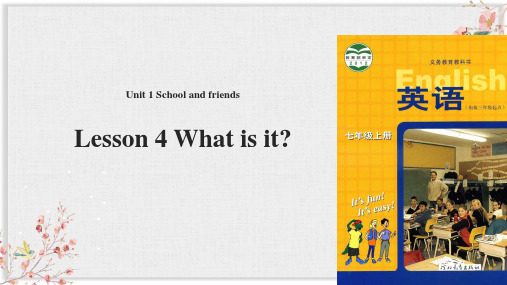
What is it?
It’s a pen .
What is it?
It’s a pencil .
What is it?
It’s a pencil box .
What is it?
It’s a ruler .
What is it?
It’s a blackboard .
What is it?
It’s an eraser .
Class, let’s play a guessing game. Li Ming, you go first.
Conversation One
Li Ming: guess?
Wang Mei: Is it a ruler? Li Ming: No, it isn’t. You can write with it.
2
4
5
6
3
1
Let’s Do It!
Play the Guessing Game in groups.
Is it a pen?
What is it?
No! Yes! Is it a pencil?
Look at the pictures and fill in the
blanks.
pencil
blackboard
You can write with a ________
ruler
The__________
is on the
wall. It’s big and black.
pen
I can see a __e_ra_s_e_r __
in the
pencil box.
Homework
Find some common objects in classroom or at home and get their English names and share with your classmates.
七年级英语下册 Unit 1 Lesson 4 A Visit to Lanzhou教案 (新版)冀教版
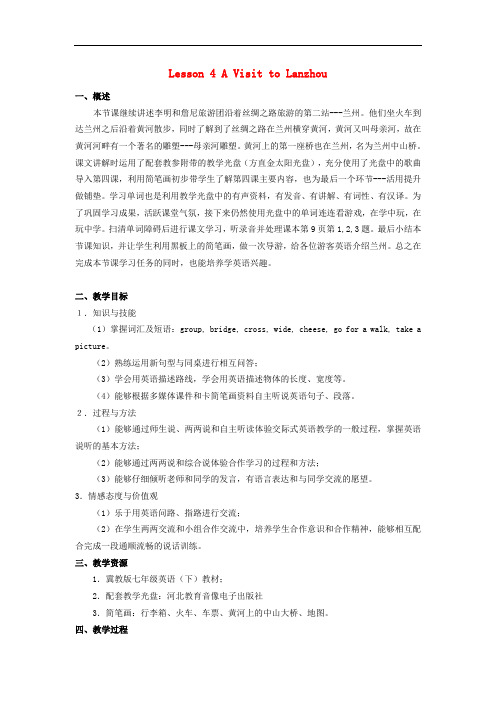
Lesson 4 A Visit to Lanzhou一、概述本节课继续讲述李明和詹尼旅游团沿着丝绸之路旅游的第二站---兰州。
他们坐火车到达兰州之后沿着黄河散步,同时了解到了丝绸之路在兰州横穿黄河,黄河又叫母亲河,故在黄河河畔有一个著名的雕塑---母亲河雕塑。
黄河上的第一座桥也在兰州,名为兰州中山桥。
课文讲解时运用了配套教参附带的教学光盘(方直金太阳光盘),充分使用了光盘中的歌曲导入第四课,利用简笔画初步带学生了解第四课主要内容,也为最后一个环节---活用提升做铺垫。
学习单词也是利用教学光盘中的有声资料,有发音、有讲解、有词性、有汉译。
为了巩固学习成果,活跃课堂气氛,接下来仍然使用光盘中的单词连连看游戏,在学中玩,在玩中学。
扫清单词障碍后进行课文学习,听录音并处理课本第9页第1,2,3题。
最后小结本节课知识,并让学生利用黑板上的简笔画,做一次导游,给各位游客英语介绍兰州。
总之在完成本节课学习任务的同时,也能培养学英语兴趣。
二、教学目标1.知识与技能(1)掌握词汇及短语:group, bridge, cross, wide, cheese, go for a walk, take a picture。
(2)熟练运用新句型与同桌进行相互问答;(3)学会用英语描述路线,学会用英语描述物体的长度、宽度等。
(4)能够根据多媒体课件和卡简笔画资料自主听说英语句子、段落。
2.过程与方法(1)能够通过师生说、两两说和自主听读体验交际式英语教学的一般过程,掌握英语说听的基本方法;(2)能够通过两两说和综合说体验合作学习的过程和方法;(3)能够仔细倾听老师和同学的发言,有语言表达和与同学交流的愿望。
3.情感态度与价值观(1)乐于用英语问路、指路进行交流;(2)在学生两两交流和小组合作交流中,培养学生合作意识和合作精神,能够相互配合完成一段通顺流畅的说话训练。
三、教学资源1.冀教版七年级英语(下)教材;2.配套教学光盘:河北教育音像电子出版社3.简笔画:行李箱、火车、车票、黄河上的中山大桥、地图。
七年级英语上册Unit1Lesson4WhatIsIt习题课件新版冀教版

D. full name
A 29. A. is
B. am
C. are D. be
I’m in Handan now. I have a new _____30. It’s from _____31
dad.
A30. A. pencil box
B. pencil
C. ruler
D. blackboard
______34 blue.
C 33. A. A
B. An
C. The
D. /
C 34. A.
D. /
_____35 is that pen? It’s black. A 35. A. What colour C. How
B. What D. What’s
Ⅶ.阅读理解。
A. three
B. two
C. four
D. one
【点拨】根据原文中句子I have 2 pens.可知答案。
40. ___C___are (is) blue. A. Frank’s books C. Frank’s pens
B. Frank’s schoolbag D. Frank’s ruler
UNIT 1 School and Friends
Lesson 4 What Is It?
提示:点击 进入习题
1 guess 2 first 3 wall 4 with 5 eraser
6 play 7 isn't 8 your 9 first 10 are
答案呈现
11 B 12 B 13 C 14 D 15 C
_W__h_a_t__is_t_h_i_s_____________________?
冀教版七年级上册英语unit1 Lesson 4 What Is It

7.—Tony, _____A___yousingEnglishsongs? —Yes, Ican. 【中考·广西北部湾经济区】 A. canB. mayC. needD. must
【点拨】由答语中can可知是由can引起的一 般疑问句。故选A。
8. Yourbookcan_____A___onthedesk. A. beB. isC. areD. do
12. 我能看见一把尺子。 I__________________aruler.
cansee
13. 这个铅笔盒很好。我喜欢它。 Thepencilboxis_________v_e_ry_g_o_o_d__/n_i.cIelikeit.
14. 她是正确的。你应该相信她。
She________i_s_ri_g_h_t_______. Youshouldbelieve__________.
It’s_______l_o_nagnthd_in_W__h_a_t___. _________isit? Canyouguess?
1. 对于学生来说,学习是第一位的。 Studycomes_______f_ir_s_tsfotur_d_e_n_ts_____.
2. XiaoFangintroduced(介绍)
3. Ourschoolisbig______A__clean(干净的). A. andB. butC. orD. so
【点拨】句意为“我们的学校又大又干净”。 表示并列关系用and,故选A。
4. Iknowhisface______B__Ican’trememberhisname. 【 中考·武威】
herselftothenewstudentsinEnglishin_________ A
冀教版七年级下册英语精品教学课件 Unit 1 Lesson 1
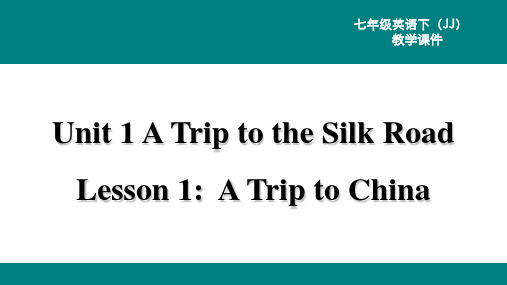
Language Points
1. We’re learning about the Silk Road this month in school. (教材P2)
learn v. 学,学习 过去式为:learned / learnt learn的常见搭配: learn about 获得;了解;学到 learn from 从......学到;向......学习
➢ To be able to ask for permission.
trip silk road lead
n. 旅行,旅程 n. 丝,丝绸 n. 路,公路 v. 带领;指路
note chance
send news
n. 便笺;笔记 n. 机会;运气 v. 寄;送 n. 新闻,消息
The Silk Road wgeats aitsnnetawmoerkfr(om网th络e)Chofintersaedseilrkoutrtaesde(a贸lon易g路it 线du)rincgonthneecHtianng DthyenEasatsyt.and the West in ancient(古代的) and Medieval times(中世纪).
The Drum
Tower
Xi'an
The TLerarnazChoottua
Warriors
Dunhuang
Presentation
Jenny: Hi, Mum! Hi, Dad! Guess what!We’re learning about the Silk Road this month in school.
lead trip chance news travel note
冀教版七年级下册英语精品教学课件 Unit 4 After-School Lesson 19
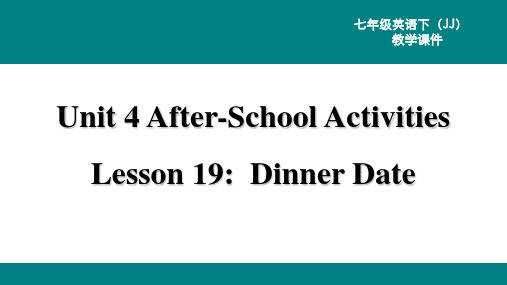
【例句】 — What / How about going swimming this afternoon? 今天下午去游泳怎么样? —Good idea! 好主意!
Talk about your schedule(日程安排) with your partner. You can use the sentence structures “What are you going to do on ... ?” “I'm going to ... on ...”
Monday Tuesday Wednesday Thursday Friday Saturday Sunday
Jim: Maybe Friday? Steven: I have math classes on Fridays. I’m not doing well in math this
year. What are you going to do this weekend? Jim: I’m going to the countryside with my dad. We are going to plant
5. I _a_m__g_o_in__g_t_o_b_e_(be) a volleyball player in the future. I enjoy volleyball so much!
4. Work in pairs. What are you going to do after school this week? Make up a dialogue.
冀教版小学英语Unit-1-Lesson-4-Nice-to-Meet-You课件
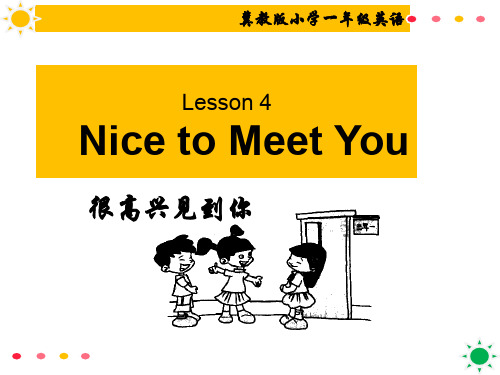
The En
d
Summary
1.学生能够理解指令: ---Go! ---Stop!
2.学生还学会运用句型: ---Nice to meet you. ---Nice to meet you too.
很高兴见到你。(第一次见面)
-Nice to meet you too.
我也很高兴见到你。
nice
to
meet The En
d
you
Nice to meet you. 很高兴见到你。
Practice
A: Hello! My name is Sun Wukong. Nice to meet you.
B: Nice to meet you too.
Practice
A: Hello! My name is Guang Touqiang. Nice to meet you.
B: Nice to meet you too.
Practice
A: Hello! My name is Baixue. Nice to meet you.
冀教版小学一年级英语
Lesson 4
Nice to Meet You
很高兴见到你
复习:
我的名字是丹尼。
A: Hi! My name is Danny. 嗨,我的名字是丹尼。 B:Hello, my name is Ling Ling. 你好,我的名字是玲玲。
第一次见面
-Nice to meet you.
B: Nice to meet you too.
Practice
A: Hello! My name is Li Chen. Nice to meet you.
B: Nice to meet you too.
- 1、下载文档前请自行甄别文档内容的完整性,平台不提供额外的编辑、内容补充、找答案等附加服务。
- 2、"仅部分预览"的文档,不可在线预览部分如存在完整性等问题,可反馈申请退款(可完整预览的文档不适用该条件!)。
- 3、如文档侵犯您的权益,请联系客服反馈,我们会尽快为您处理(人工客服工作时间:9:00-18:30)。
18
d. 以辅音字母加 y 结尾的双音节词改 y 为 i,再加-er 和-est。如:easy-easier-easiest;heavy-heavier-
heaviest
f. 多音节词和部分双音节词,在词前加 more 和 most。 如:careful-more careful-most careful;beautifulmore beautiful-most beautiful
20
Try to retell the story: 1. Li Ming, want, go by plane 2. but, his mother, want, take a bus 3. a train, slower than, a plane, but faster than, a bus 4. and, not too expensive 5. so, will take a train (go by train)
19
(2)形容词比较级的用法如下: 表示两个人或事物进行比较时,用比较级。基本句型为: 主语+谓语(系动词)+形容词比较级+than+对比成分。 例如: He is taller than his father. 他比他父亲高。 This box is heavier than that one. 这个盒子比那个盒子重。 This shirt is cheaper than that one. 这件衬衫比那件衬衫便宜。 两者比较时,若强调其中的一方,基本句型为: 主语+谓 语(系动词)+the+比较级+of the two…。例如: Mary is the younger girl of the two. 玛丽是这两个女孩 中较年轻的一个。
bus
A train is slower than a plane but faster than a bus.
12
Original degrees
fast slow tall cheap expensive
Comparative degrees
faster slower taller cheaper
than conj. 比
us pron. 我们
check v. 检查;核实
as adv. 同样地;像……一样
3
Read the diary and answer the questions
1. How are Danny and Jenny going to travel from By plane Edmonton to Beijing?
take a car
take a train take a plane
7
by bicycle by bus by car by train by plane
= on one’s bicycle = on a bus = in one’s car = on a train
= on a plane
8
Practise this dialogue:
22
Please, not a bus Let’s take a train It’s faster than a bus And cheaper than a plane A train’s just right Oh, hooray, Li Ming We can take a train On our trip to Beijing
24
25
23
句型转换
1. He wants to go to Shanghai by train.(对划线部分提问) How _____ does he go to Shanghai? ______
2. It’s about 2,300 kilometres from here to there.(对划线 部分提问)
expensive
fast small cold go short
5
bicycle(bike)
car
motorbike
bus
train
airplane(plane)
6
walk
take a bike take o by bike
= go by bus
= go by car = go by train = go by plane
______ ______ it from here to there? How far ______ is
3. A train is slow and a plane is fast.(改为同义句)
A train is _____ slower_____ than a plane. 4. The car costs so much.(改为否定句) The car doesn’t _____ _____ cost so much.
21
Let’s sing a song!
A plane is fast. A bus is slow. Let’s take plane. That is how I want to go. A plane is fast. But let’s take a bus. A bus is slow. But it doesn't cost much.
16
4.But a plane is fast!A bus is slow! 但是坐飞机快,而坐汽车慢。 句中 fast 是形容词,意为 “快的”。反义词是 slow,比 较级为 faster。slow 的比较级为 slower。例如: a fast car 一辆速度快的小汽车
A train is faster than a bus. 火车比公共汽车快。
14
2.I want to meet them at the airport in Beijing with my mom and dad. 我想和我的爸爸妈妈在北京机场接他们。 句中 want to do sth.意为 “想要去做某事”,此时 want 相当于 would like,只是 would like 的语气较委婉。 例如: I want to go swimming.=I would like to go swimming. 我想要去游泳。 Bill wants to be a doctor. 比尔想要当一名医生。
fast 也可以作副词,修饰动词。例如: He can’t walk very fast. 他不能走得太快。 Li Ming runs faster than I. 李明比我跑得快。
17
语法点拨
本课涉及到了形容词的比较级。形容词还有最高级形 式。 (1)形容词比较级、最高级的变化规则如下: a.一般在词尾加-er和-est。如:cheap-cheaper-cheapest b.以字母e结尾的加-r和-st。如:nice-nicer-nicest c.重读闭音节,词尾只有一个辅音字母,双写这个辅音 字母,再加-er和-est。如:big-bigger-biggest
Lesson 4 How Can We Go to Beijing?
1
Think about it
Do you like traveling ? Why?
How do you like to travel? How dose Li Ming like to travel?
2
Read the new words
more expensive
13
Language points
1. They are going to travel by plane from Edmonton to
Beijing. 他们打算从埃德蒙顿乘飞机到北京。 by plane 乘飞机。by 是介词,意为 “靠;乘;骑”, 表示借助手段或方法,后接表示交通工具的名词,前 面不加冠词。例如: by car 乘小汽车 by bike 乘自行车 by train 乘火车 by motor 骑摩托车
注意:want 表示 “想要”时,不用于进行时态。
15
3. We can take a train. 我们可以乘一辆火车。 (1)在本句中 take 为动词,意思是 “乘坐”。例如: take a bus 乘公共汽车 (2)take 还有 “拿”的意思。指把某人或某物从说话 人处带到另一处。例如:Don’t forget to take your coat. 别忘了带上你的外套。 Please take your book away. 请把你的书带走。 (3)与 take 有关的短语有:take sb./sth. to sp. 表示 “把某人或某物带到某处。take sth. with sb. 表示 “某 人携带某物”。take +名词/代词+地点副词” 表示 “把……带到……”。
About eleven hours. 2. How long is their travel? No, he doesn’t. 3. Does Li Ming know how much a train costs?
4
Find the opposites in this lesson
cheap
slow big hot come long
A: How do you go to …?
B: I go to …by/ on…
9
motorbike A motorbike is faster than a bike.
bike
10
bus A bus is slower than a car.
car
11
train
plane A train is slower than a plane. A train is faster than a bus.
